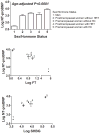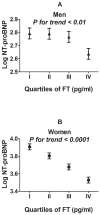Influence of sex and hormone status on circulating natriuretic peptides
- PMID: 21798425
- PMCID: PMC3170816
- DOI: 10.1016/j.jacc.2011.03.042
Influence of sex and hormone status on circulating natriuretic peptides
Abstract
Objectives: The aim of this study was to assess the relationship between sex hormones and natriuretic peptide levels in community-based adults.
Background: Women have higher circulating natriuretic peptide concentrations than men, but the mechanisms for these sex-related differences and the impact of hormone therapy are unclear. Experimental studies suggest that androgens may suppress natriuretic peptide secretion.
Methods: We measured N-terminal pro-B-type natriuretic peptide (NT-proBNP), total testosterone, and sex hormone-binding globulin plasma levels in 4,056 men and women (mean age 40 ± 9 years) from the Framingham Heart Study Third-Generation cohort. Sex/hormone status was grouped as: 1) men; 2) post-menopausal women not receiving hormone replacement therapy; 3) pre-menopausal women not receiving hormonal contraceptives; 4) post-menopausal women receiving hormone replacement therapy; and 5) pre-menopausal women receiving hormonal contraceptives.
Results: Circulating NT-proBNP levels were associated with sex/hormone status (overall p < 0.0001). Men had lower NT-proBNP levels than women of all menopause or hormone groups, and women receiving hormonal contraceptives had higher NT-proBNP levels than women who were not receiving hormone therapy (all p < 0.0001). These relationships remained significant after adjusting for age, body mass index, and cardiovascular risk factors. Across sex/hormone status groups, free testosterone (FT) levels decreased and sex hormone-binding globulin levels increased in tandem with increasing NT-proBNP levels. In sex-specific analyses, NT-proBNP levels decreased across increasing quartiles of FT in men (p for trend <0.01) and women (p for trend <0.0001). Adjustment for FT markedly attenuated the association between sex/hormone status and NT-proBNP concentrations.
Conclusions: These findings suggest that lower levels of circulating androgens and the potentiating effect of exogenous female hormone therapy contribute to the higher circulating NT-proBNP concentrations in women.
Copyright © 2011 American College of Cardiology Foundation. Published by Elsevier Inc. All rights reserved.
Figures



Comment in
-
When gonads talk to the heart sex hormones and cardiac endocrine function.J Am Coll Cardiol. 2011 Aug 2;58(6):627-8. doi: 10.1016/j.jacc.2011.03.043. J Am Coll Cardiol. 2011. PMID: 21798426 No abstract available.
References
-
- Grodstein F, Stampfer M. The epidemiology of coronary heart disease and estrogen replacement in postmenopausal women. Prog Cardiovasc Dis. 1995;38:199–210. - PubMed
-
- Rossouw JE, Anderson GL, Prentice RL, et al. Risks and benefits of estrogen plus progestin in healthy postmenopausal women: principal results From the Women’s Health Initiative randomized controlled trial. JAMA. 2002;288:321–33. - PubMed
-
- Beral V. Breast cancer and hormone-replacement therapy in the Million Women Study. Lancet. 2003;362:419–27. - PubMed
-
- Wang TJ, Larson MG, Levy D, et al. Impact of age and sex on plasma natriuretic peptide levels in healthy adults. Am J Cardiol. 2002;90:254–8. - PubMed
-
- Vasan RS, Benjamin EJ, Larson MG, et al. Plasma natriuretic peptides for community screening for left ventricular hypertrophy and systolic dysfunction: the Framingham heart study. JAMA. 2002;288:1252–9. - PubMed
Publication types
MeSH terms
Substances
Grants and funding
LinkOut - more resources
Full Text Sources
Research Materials

